Perioperative Patient Management: A Case Study in Nursing Practice
VerifiedAdded on 2021/06/15
|13
|3401
|22
Case Study
AI Summary
This case study focuses on the perioperative management of a patient with benign prostate hypertrophy undergoing a transurethral resection of the prostate (TURP). The patient's background includes a history of coronary artery disease, mitral valve replacement, and atrial fibrillation, necessitating careful consideration of pre-operative medications like warfarin. The case study details the patient's profile, including health history, investigation results (echocardiogram, blood tests), and planned treatment. It outlines the surgical procedure, anesthesia considerations, and potential risks. The core of the case study lies in the nursing management, encompassing pre-operative assessment (Glasgow Coma Scale, cardiovascular, respiratory, and genitourinary systems), identification of patient needs (pain management, risk of bleeding, fluid balance), and the development of nursing diagnoses (impaired urinary elimination, acute pain, risk for infection, risk for deficient volume). The nursing care plan includes interventions such as monitoring vital signs, managing pain, maintaining catheter patency, preventing infection, and ensuring adequate fluid balance. The case study also addresses pharmacological management, including the use of enoxaparin, augmentin and the discontinuation of warfarin. The post-operative management focuses on preventing complications and ensuring the patient's recovery. The document provides a valuable framework for understanding the complexities of perioperative patient care.

Running head: PERIOPERATIVE PATIENT MANAGEMENT.
Perioperative Patient Management
Name of Student
Institutional affiliation
Perioperative Patient Management
Name of Student
Institutional affiliation
Paraphrase This Document
Need a fresh take? Get an instant paraphrase of this document with our AI Paraphraser
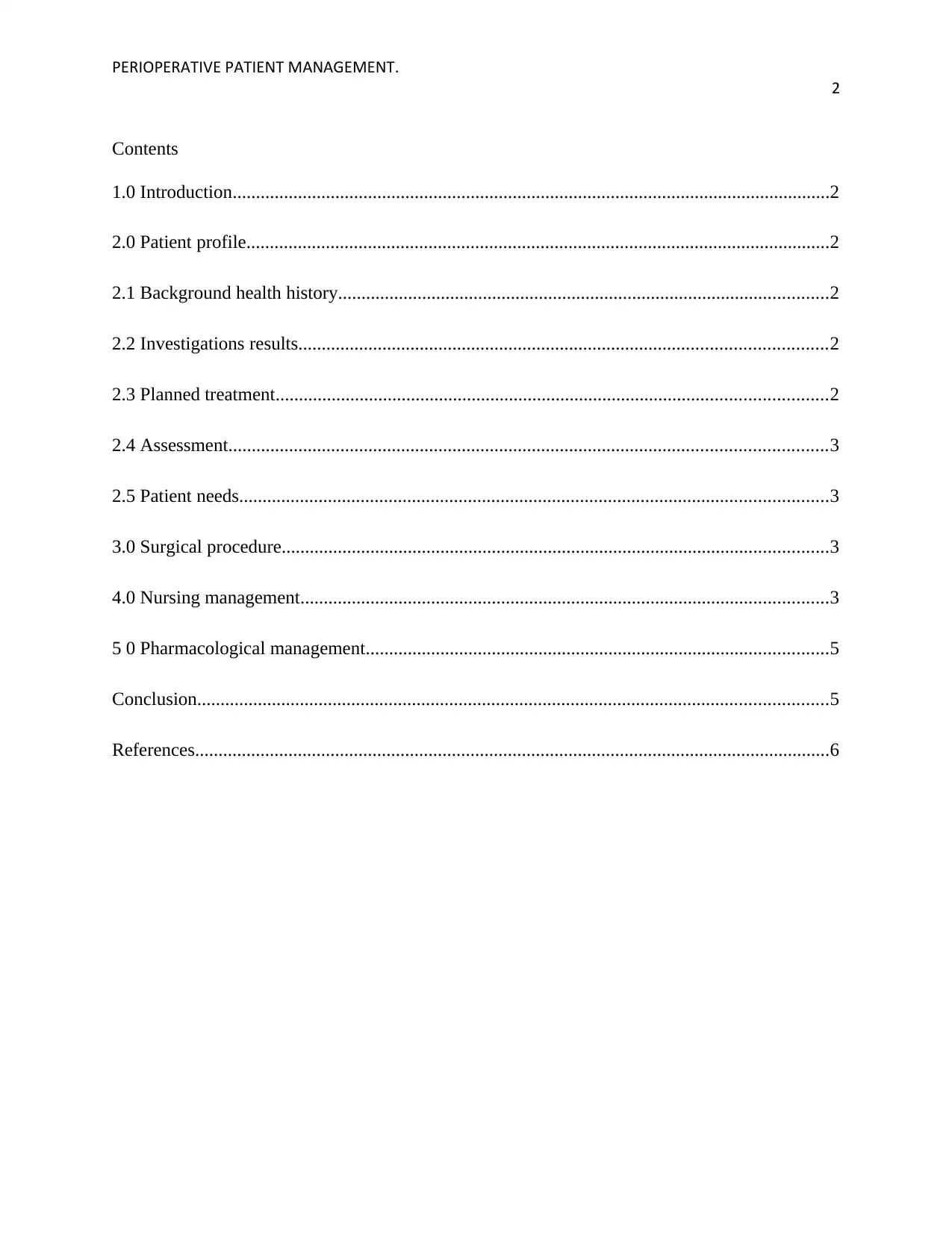
PERIOPERATIVE PATIENT MANAGEMENT.
2
Contents
1.0 Introduction................................................................................................................................2
2.0 Patient profile.............................................................................................................................2
2.1 Background health history.........................................................................................................2
2.2 Investigations results.................................................................................................................2
2.3 Planned treatment......................................................................................................................2
2.4 Assessment................................................................................................................................3
2.5 Patient needs..............................................................................................................................3
3.0 Surgical procedure.....................................................................................................................3
4.0 Nursing management.................................................................................................................3
5 0 Pharmacological management...................................................................................................5
Conclusion.......................................................................................................................................5
References........................................................................................................................................6
2
Contents
1.0 Introduction................................................................................................................................2
2.0 Patient profile.............................................................................................................................2
2.1 Background health history.........................................................................................................2
2.2 Investigations results.................................................................................................................2
2.3 Planned treatment......................................................................................................................2
2.4 Assessment................................................................................................................................3
2.5 Patient needs..............................................................................................................................3
3.0 Surgical procedure.....................................................................................................................3
4.0 Nursing management.................................................................................................................3
5 0 Pharmacological management...................................................................................................5
Conclusion.......................................................................................................................................5
References........................................................................................................................................6
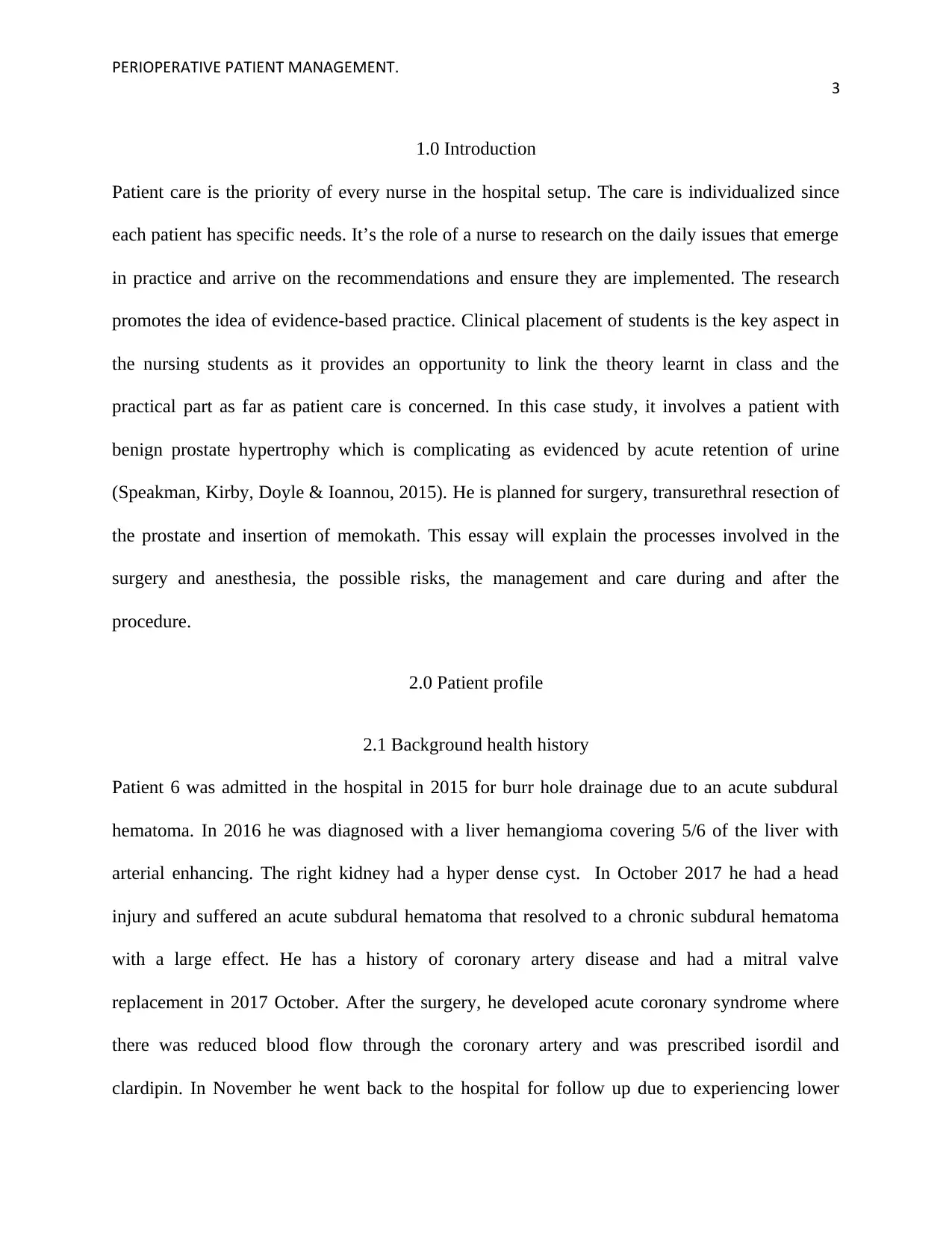
PERIOPERATIVE PATIENT MANAGEMENT.
3
1.0 Introduction
Patient care is the priority of every nurse in the hospital setup. The care is individualized since
each patient has specific needs. It’s the role of a nurse to research on the daily issues that emerge
in practice and arrive on the recommendations and ensure they are implemented. The research
promotes the idea of evidence-based practice. Clinical placement of students is the key aspect in
the nursing students as it provides an opportunity to link the theory learnt in class and the
practical part as far as patient care is concerned. In this case study, it involves a patient with
benign prostate hypertrophy which is complicating as evidenced by acute retention of urine
(Speakman, Kirby, Doyle & Ioannou, 2015). He is planned for surgery, transurethral resection of
the prostate and insertion of memokath. This essay will explain the processes involved in the
surgery and anesthesia, the possible risks, the management and care during and after the
procedure.
2.0 Patient profile
2.1 Background health history
Patient 6 was admitted in the hospital in 2015 for burr hole drainage due to an acute subdural
hematoma. In 2016 he was diagnosed with a liver hemangioma covering 5/6 of the liver with
arterial enhancing. The right kidney had a hyper dense cyst. In October 2017 he had a head
injury and suffered an acute subdural hematoma that resolved to a chronic subdural hematoma
with a large effect. He has a history of coronary artery disease and had a mitral valve
replacement in 2017 October. After the surgery, he developed acute coronary syndrome where
there was reduced blood flow through the coronary artery and was prescribed isordil and
clardipin. In November he went back to the hospital for follow up due to experiencing lower
3
1.0 Introduction
Patient care is the priority of every nurse in the hospital setup. The care is individualized since
each patient has specific needs. It’s the role of a nurse to research on the daily issues that emerge
in practice and arrive on the recommendations and ensure they are implemented. The research
promotes the idea of evidence-based practice. Clinical placement of students is the key aspect in
the nursing students as it provides an opportunity to link the theory learnt in class and the
practical part as far as patient care is concerned. In this case study, it involves a patient with
benign prostate hypertrophy which is complicating as evidenced by acute retention of urine
(Speakman, Kirby, Doyle & Ioannou, 2015). He is planned for surgery, transurethral resection of
the prostate and insertion of memokath. This essay will explain the processes involved in the
surgery and anesthesia, the possible risks, the management and care during and after the
procedure.
2.0 Patient profile
2.1 Background health history
Patient 6 was admitted in the hospital in 2015 for burr hole drainage due to an acute subdural
hematoma. In 2016 he was diagnosed with a liver hemangioma covering 5/6 of the liver with
arterial enhancing. The right kidney had a hyper dense cyst. In October 2017 he had a head
injury and suffered an acute subdural hematoma that resolved to a chronic subdural hematoma
with a large effect. He has a history of coronary artery disease and had a mitral valve
replacement in 2017 October. After the surgery, he developed acute coronary syndrome where
there was reduced blood flow through the coronary artery and was prescribed isordil and
clardipin. In November he went back to the hospital for follow up due to experiencing lower
⊘ This is a preview!⊘
Do you want full access?
Subscribe today to unlock all pages.

Trusted by 1+ million students worldwide
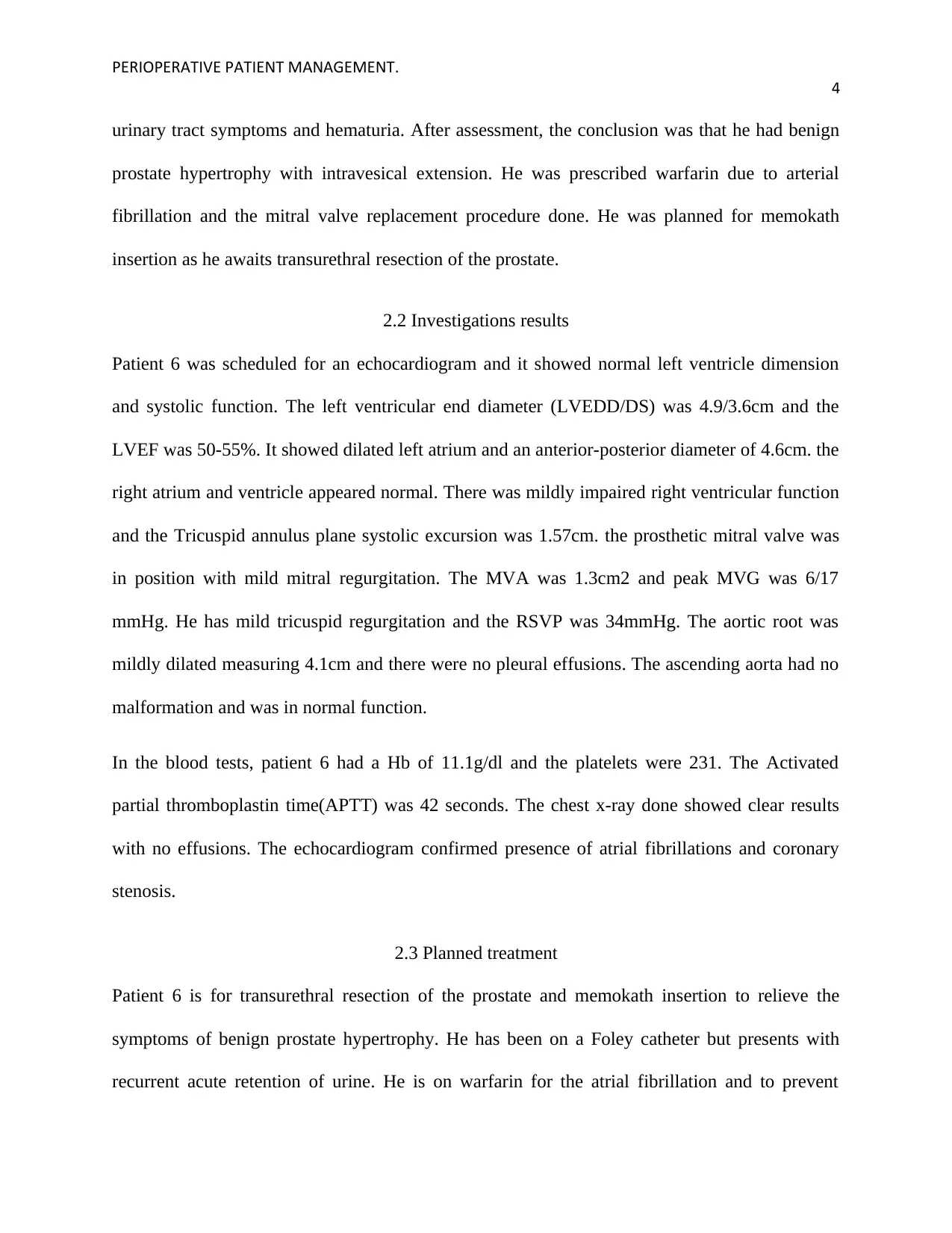
PERIOPERATIVE PATIENT MANAGEMENT.
4
urinary tract symptoms and hematuria. After assessment, the conclusion was that he had benign
prostate hypertrophy with intravesical extension. He was prescribed warfarin due to arterial
fibrillation and the mitral valve replacement procedure done. He was planned for memokath
insertion as he awaits transurethral resection of the prostate.
2.2 Investigations results
Patient 6 was scheduled for an echocardiogram and it showed normal left ventricle dimension
and systolic function. The left ventricular end diameter (LVEDD/DS) was 4.9/3.6cm and the
LVEF was 50-55%. It showed dilated left atrium and an anterior-posterior diameter of 4.6cm. the
right atrium and ventricle appeared normal. There was mildly impaired right ventricular function
and the Tricuspid annulus plane systolic excursion was 1.57cm. the prosthetic mitral valve was
in position with mild mitral regurgitation. The MVA was 1.3cm2 and peak MVG was 6/17
mmHg. He has mild tricuspid regurgitation and the RSVP was 34mmHg. The aortic root was
mildly dilated measuring 4.1cm and there were no pleural effusions. The ascending aorta had no
malformation and was in normal function.
In the blood tests, patient 6 had a Hb of 11.1g/dl and the platelets were 231. The Activated
partial thromboplastin time(APTT) was 42 seconds. The chest x-ray done showed clear results
with no effusions. The echocardiogram confirmed presence of atrial fibrillations and coronary
stenosis.
2.3 Planned treatment
Patient 6 is for transurethral resection of the prostate and memokath insertion to relieve the
symptoms of benign prostate hypertrophy. He has been on a Foley catheter but presents with
recurrent acute retention of urine. He is on warfarin for the atrial fibrillation and to prevent
4
urinary tract symptoms and hematuria. After assessment, the conclusion was that he had benign
prostate hypertrophy with intravesical extension. He was prescribed warfarin due to arterial
fibrillation and the mitral valve replacement procedure done. He was planned for memokath
insertion as he awaits transurethral resection of the prostate.
2.2 Investigations results
Patient 6 was scheduled for an echocardiogram and it showed normal left ventricle dimension
and systolic function. The left ventricular end diameter (LVEDD/DS) was 4.9/3.6cm and the
LVEF was 50-55%. It showed dilated left atrium and an anterior-posterior diameter of 4.6cm. the
right atrium and ventricle appeared normal. There was mildly impaired right ventricular function
and the Tricuspid annulus plane systolic excursion was 1.57cm. the prosthetic mitral valve was
in position with mild mitral regurgitation. The MVA was 1.3cm2 and peak MVG was 6/17
mmHg. He has mild tricuspid regurgitation and the RSVP was 34mmHg. The aortic root was
mildly dilated measuring 4.1cm and there were no pleural effusions. The ascending aorta had no
malformation and was in normal function.
In the blood tests, patient 6 had a Hb of 11.1g/dl and the platelets were 231. The Activated
partial thromboplastin time(APTT) was 42 seconds. The chest x-ray done showed clear results
with no effusions. The echocardiogram confirmed presence of atrial fibrillations and coronary
stenosis.
2.3 Planned treatment
Patient 6 is for transurethral resection of the prostate and memokath insertion to relieve the
symptoms of benign prostate hypertrophy. He has been on a Foley catheter but presents with
recurrent acute retention of urine. He is on warfarin for the atrial fibrillation and to prevent
Paraphrase This Document
Need a fresh take? Get an instant paraphrase of this document with our AI Paraphraser
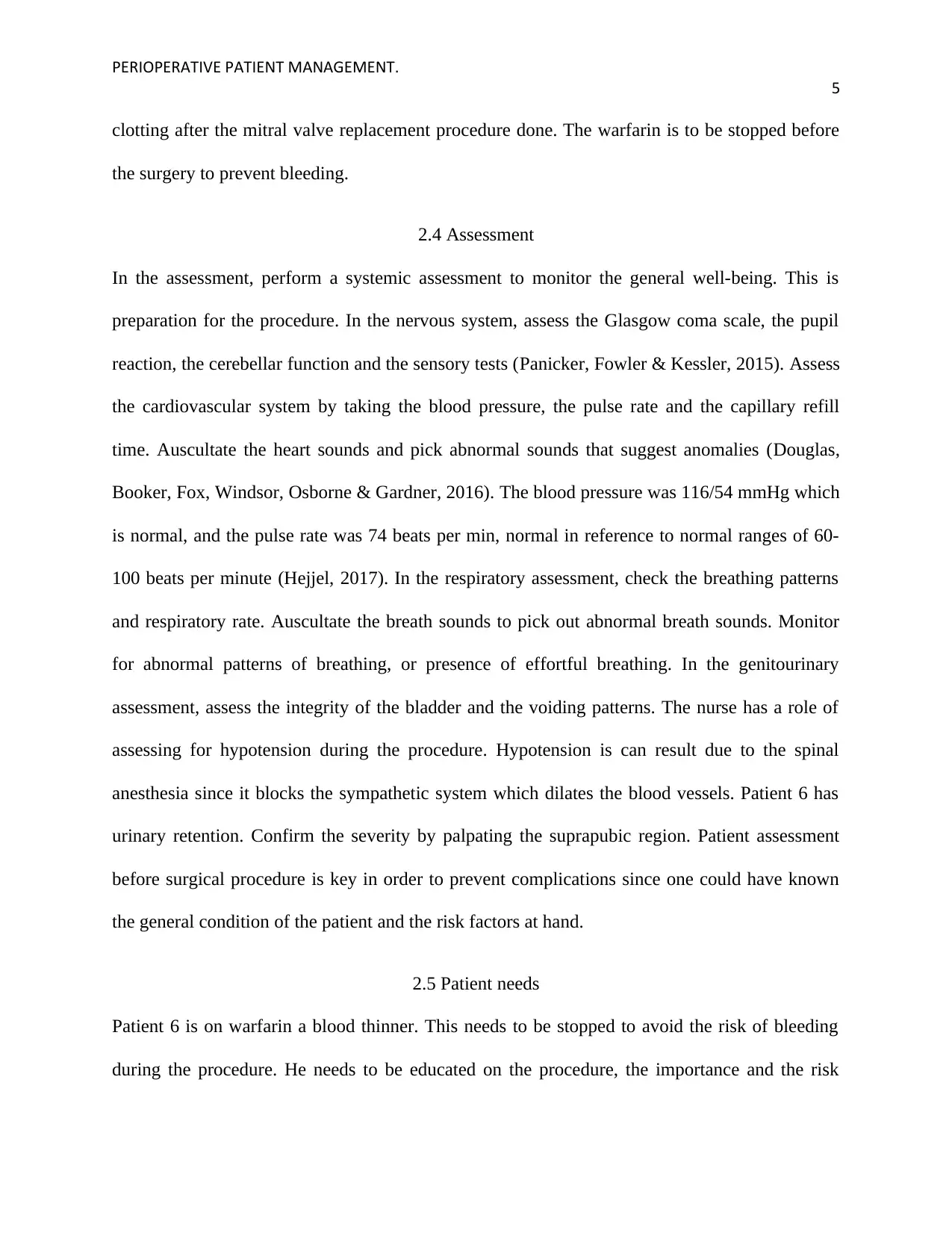
PERIOPERATIVE PATIENT MANAGEMENT.
5
clotting after the mitral valve replacement procedure done. The warfarin is to be stopped before
the surgery to prevent bleeding.
2.4 Assessment
In the assessment, perform a systemic assessment to monitor the general well-being. This is
preparation for the procedure. In the nervous system, assess the Glasgow coma scale, the pupil
reaction, the cerebellar function and the sensory tests (Panicker, Fowler & Kessler, 2015). Assess
the cardiovascular system by taking the blood pressure, the pulse rate and the capillary refill
time. Auscultate the heart sounds and pick abnormal sounds that suggest anomalies (Douglas,
Booker, Fox, Windsor, Osborne & Gardner, 2016). The blood pressure was 116/54 mmHg which
is normal, and the pulse rate was 74 beats per min, normal in reference to normal ranges of 60-
100 beats per minute (Hejjel, 2017). In the respiratory assessment, check the breathing patterns
and respiratory rate. Auscultate the breath sounds to pick out abnormal breath sounds. Monitor
for abnormal patterns of breathing, or presence of effortful breathing. In the genitourinary
assessment, assess the integrity of the bladder and the voiding patterns. The nurse has a role of
assessing for hypotension during the procedure. Hypotension is can result due to the spinal
anesthesia since it blocks the sympathetic system which dilates the blood vessels. Patient 6 has
urinary retention. Confirm the severity by palpating the suprapubic region. Patient assessment
before surgical procedure is key in order to prevent complications since one could have known
the general condition of the patient and the risk factors at hand.
2.5 Patient needs
Patient 6 is on warfarin a blood thinner. This needs to be stopped to avoid the risk of bleeding
during the procedure. He needs to be educated on the procedure, the importance and the risk
5
clotting after the mitral valve replacement procedure done. The warfarin is to be stopped before
the surgery to prevent bleeding.
2.4 Assessment
In the assessment, perform a systemic assessment to monitor the general well-being. This is
preparation for the procedure. In the nervous system, assess the Glasgow coma scale, the pupil
reaction, the cerebellar function and the sensory tests (Panicker, Fowler & Kessler, 2015). Assess
the cardiovascular system by taking the blood pressure, the pulse rate and the capillary refill
time. Auscultate the heart sounds and pick abnormal sounds that suggest anomalies (Douglas,
Booker, Fox, Windsor, Osborne & Gardner, 2016). The blood pressure was 116/54 mmHg which
is normal, and the pulse rate was 74 beats per min, normal in reference to normal ranges of 60-
100 beats per minute (Hejjel, 2017). In the respiratory assessment, check the breathing patterns
and respiratory rate. Auscultate the breath sounds to pick out abnormal breath sounds. Monitor
for abnormal patterns of breathing, or presence of effortful breathing. In the genitourinary
assessment, assess the integrity of the bladder and the voiding patterns. The nurse has a role of
assessing for hypotension during the procedure. Hypotension is can result due to the spinal
anesthesia since it blocks the sympathetic system which dilates the blood vessels. Patient 6 has
urinary retention. Confirm the severity by palpating the suprapubic region. Patient assessment
before surgical procedure is key in order to prevent complications since one could have known
the general condition of the patient and the risk factors at hand.
2.5 Patient needs
Patient 6 is on warfarin a blood thinner. This needs to be stopped to avoid the risk of bleeding
during the procedure. He needs to be educated on the procedure, the importance and the risk
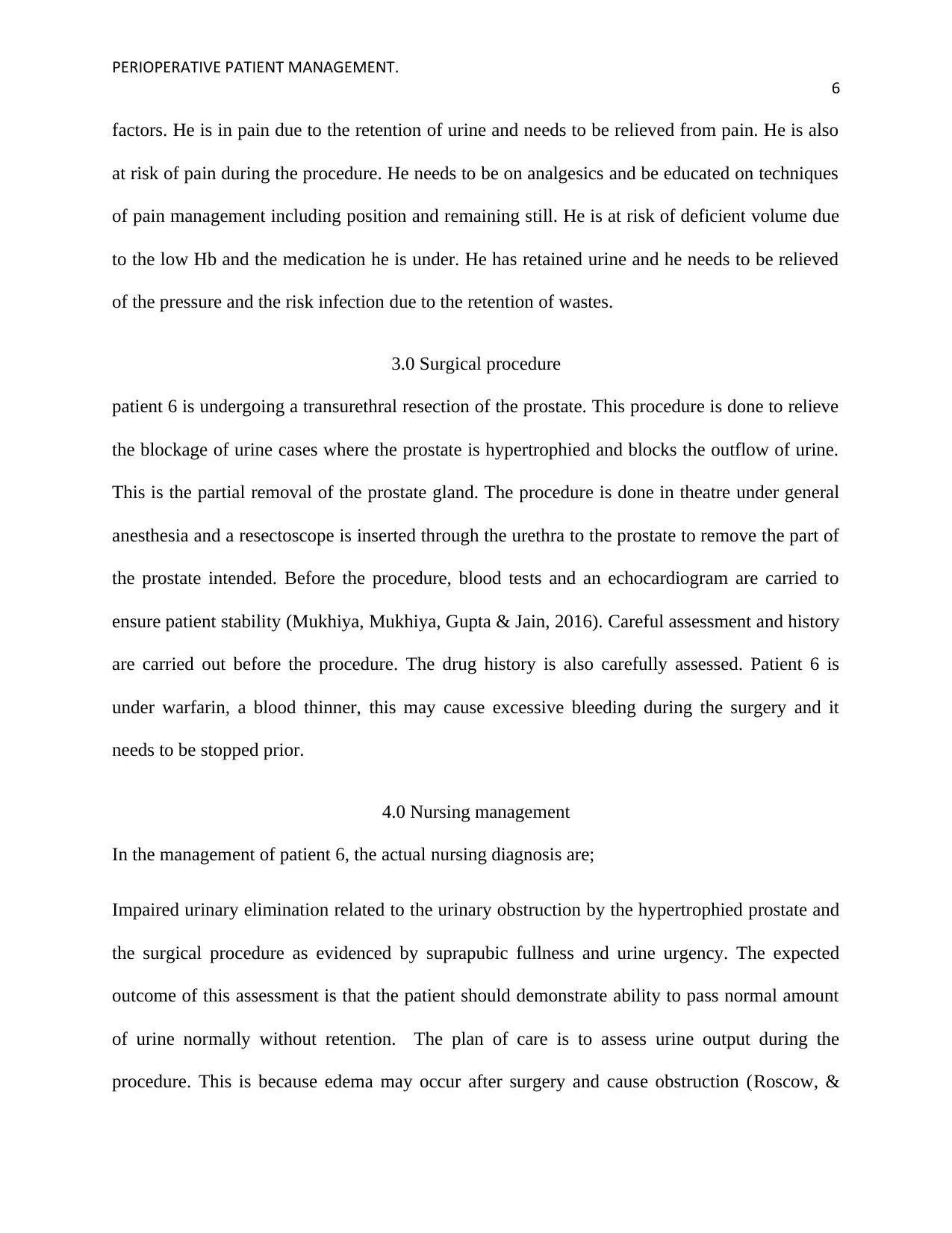
PERIOPERATIVE PATIENT MANAGEMENT.
6
factors. He is in pain due to the retention of urine and needs to be relieved from pain. He is also
at risk of pain during the procedure. He needs to be on analgesics and be educated on techniques
of pain management including position and remaining still. He is at risk of deficient volume due
to the low Hb and the medication he is under. He has retained urine and he needs to be relieved
of the pressure and the risk infection due to the retention of wastes.
3.0 Surgical procedure
patient 6 is undergoing a transurethral resection of the prostate. This procedure is done to relieve
the blockage of urine cases where the prostate is hypertrophied and blocks the outflow of urine.
This is the partial removal of the prostate gland. The procedure is done in theatre under general
anesthesia and a resectoscope is inserted through the urethra to the prostate to remove the part of
the prostate intended. Before the procedure, blood tests and an echocardiogram are carried to
ensure patient stability (Mukhiya, Mukhiya, Gupta & Jain, 2016). Careful assessment and history
are carried out before the procedure. The drug history is also carefully assessed. Patient 6 is
under warfarin, a blood thinner, this may cause excessive bleeding during the surgery and it
needs to be stopped prior.
4.0 Nursing management
In the management of patient 6, the actual nursing diagnosis are;
Impaired urinary elimination related to the urinary obstruction by the hypertrophied prostate and
the surgical procedure as evidenced by suprapubic fullness and urine urgency. The expected
outcome of this assessment is that the patient should demonstrate ability to pass normal amount
of urine normally without retention. The plan of care is to assess urine output during the
procedure. This is because edema may occur after surgery and cause obstruction (Roscow, &
6
factors. He is in pain due to the retention of urine and needs to be relieved from pain. He is also
at risk of pain during the procedure. He needs to be on analgesics and be educated on techniques
of pain management including position and remaining still. He is at risk of deficient volume due
to the low Hb and the medication he is under. He has retained urine and he needs to be relieved
of the pressure and the risk infection due to the retention of wastes.
3.0 Surgical procedure
patient 6 is undergoing a transurethral resection of the prostate. This procedure is done to relieve
the blockage of urine cases where the prostate is hypertrophied and blocks the outflow of urine.
This is the partial removal of the prostate gland. The procedure is done in theatre under general
anesthesia and a resectoscope is inserted through the urethra to the prostate to remove the part of
the prostate intended. Before the procedure, blood tests and an echocardiogram are carried to
ensure patient stability (Mukhiya, Mukhiya, Gupta & Jain, 2016). Careful assessment and history
are carried out before the procedure. The drug history is also carefully assessed. Patient 6 is
under warfarin, a blood thinner, this may cause excessive bleeding during the surgery and it
needs to be stopped prior.
4.0 Nursing management
In the management of patient 6, the actual nursing diagnosis are;
Impaired urinary elimination related to the urinary obstruction by the hypertrophied prostate and
the surgical procedure as evidenced by suprapubic fullness and urine urgency. The expected
outcome of this assessment is that the patient should demonstrate ability to pass normal amount
of urine normally without retention. The plan of care is to assess urine output during the
procedure. This is because edema may occur after surgery and cause obstruction (Roscow, &
⊘ This is a preview!⊘
Do you want full access?
Subscribe today to unlock all pages.

Trusted by 1+ million students worldwide
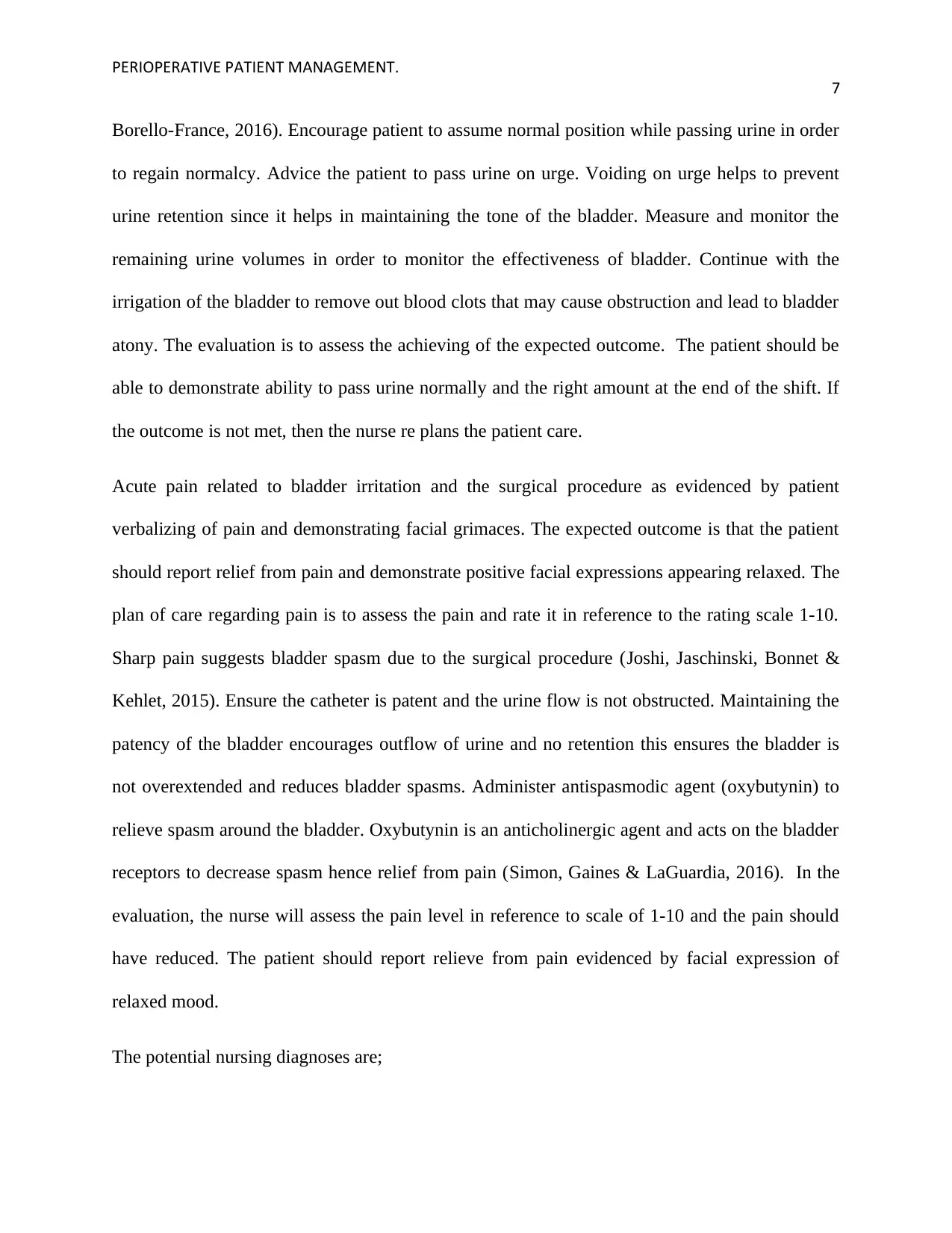
PERIOPERATIVE PATIENT MANAGEMENT.
7
Borello-France, 2016). Encourage patient to assume normal position while passing urine in order
to regain normalcy. Advice the patient to pass urine on urge. Voiding on urge helps to prevent
urine retention since it helps in maintaining the tone of the bladder. Measure and monitor the
remaining urine volumes in order to monitor the effectiveness of bladder. Continue with the
irrigation of the bladder to remove out blood clots that may cause obstruction and lead to bladder
atony. The evaluation is to assess the achieving of the expected outcome. The patient should be
able to demonstrate ability to pass urine normally and the right amount at the end of the shift. If
the outcome is not met, then the nurse re plans the patient care.
Acute pain related to bladder irritation and the surgical procedure as evidenced by patient
verbalizing of pain and demonstrating facial grimaces. The expected outcome is that the patient
should report relief from pain and demonstrate positive facial expressions appearing relaxed. The
plan of care regarding pain is to assess the pain and rate it in reference to the rating scale 1-10.
Sharp pain suggests bladder spasm due to the surgical procedure (Joshi, Jaschinski, Bonnet &
Kehlet, 2015). Ensure the catheter is patent and the urine flow is not obstructed. Maintaining the
patency of the bladder encourages outflow of urine and no retention this ensures the bladder is
not overextended and reduces bladder spasms. Administer antispasmodic agent (oxybutynin) to
relieve spasm around the bladder. Oxybutynin is an anticholinergic agent and acts on the bladder
receptors to decrease spasm hence relief from pain (Simon, Gaines & LaGuardia, 2016). In the
evaluation, the nurse will assess the pain level in reference to scale of 1-10 and the pain should
have reduced. The patient should report relieve from pain evidenced by facial expression of
relaxed mood.
The potential nursing diagnoses are;
7
Borello-France, 2016). Encourage patient to assume normal position while passing urine in order
to regain normalcy. Advice the patient to pass urine on urge. Voiding on urge helps to prevent
urine retention since it helps in maintaining the tone of the bladder. Measure and monitor the
remaining urine volumes in order to monitor the effectiveness of bladder. Continue with the
irrigation of the bladder to remove out blood clots that may cause obstruction and lead to bladder
atony. The evaluation is to assess the achieving of the expected outcome. The patient should be
able to demonstrate ability to pass urine normally and the right amount at the end of the shift. If
the outcome is not met, then the nurse re plans the patient care.
Acute pain related to bladder irritation and the surgical procedure as evidenced by patient
verbalizing of pain and demonstrating facial grimaces. The expected outcome is that the patient
should report relief from pain and demonstrate positive facial expressions appearing relaxed. The
plan of care regarding pain is to assess the pain and rate it in reference to the rating scale 1-10.
Sharp pain suggests bladder spasm due to the surgical procedure (Joshi, Jaschinski, Bonnet &
Kehlet, 2015). Ensure the catheter is patent and the urine flow is not obstructed. Maintaining the
patency of the bladder encourages outflow of urine and no retention this ensures the bladder is
not overextended and reduces bladder spasms. Administer antispasmodic agent (oxybutynin) to
relieve spasm around the bladder. Oxybutynin is an anticholinergic agent and acts on the bladder
receptors to decrease spasm hence relief from pain (Simon, Gaines & LaGuardia, 2016). In the
evaluation, the nurse will assess the pain level in reference to scale of 1-10 and the pain should
have reduced. The patient should report relieve from pain evidenced by facial expression of
relaxed mood.
The potential nursing diagnoses are;
Paraphrase This Document
Need a fresh take? Get an instant paraphrase of this document with our AI Paraphraser
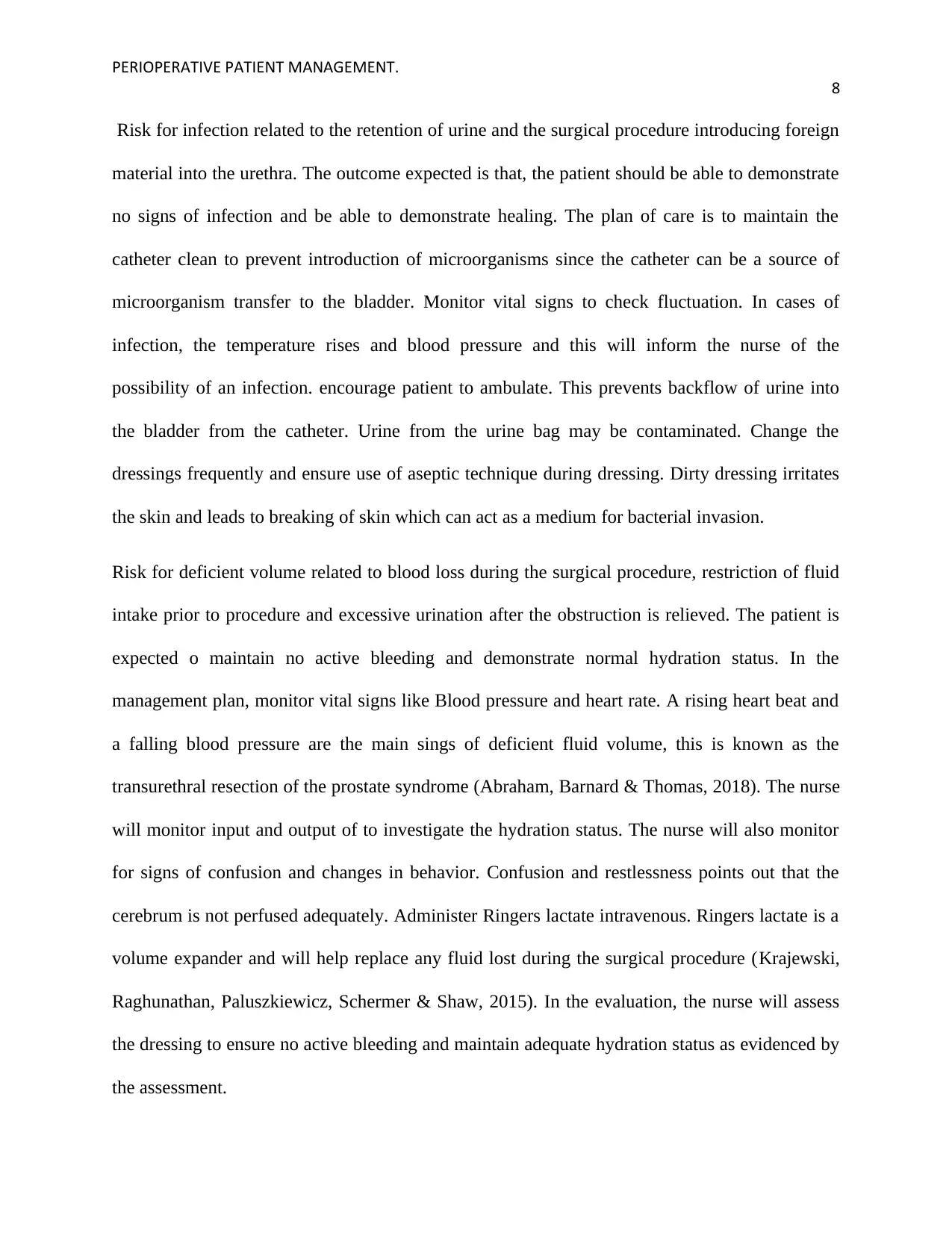
PERIOPERATIVE PATIENT MANAGEMENT.
8
Risk for infection related to the retention of urine and the surgical procedure introducing foreign
material into the urethra. The outcome expected is that, the patient should be able to demonstrate
no signs of infection and be able to demonstrate healing. The plan of care is to maintain the
catheter clean to prevent introduction of microorganisms since the catheter can be a source of
microorganism transfer to the bladder. Monitor vital signs to check fluctuation. In cases of
infection, the temperature rises and blood pressure and this will inform the nurse of the
possibility of an infection. encourage patient to ambulate. This prevents backflow of urine into
the bladder from the catheter. Urine from the urine bag may be contaminated. Change the
dressings frequently and ensure use of aseptic technique during dressing. Dirty dressing irritates
the skin and leads to breaking of skin which can act as a medium for bacterial invasion.
Risk for deficient volume related to blood loss during the surgical procedure, restriction of fluid
intake prior to procedure and excessive urination after the obstruction is relieved. The patient is
expected o maintain no active bleeding and demonstrate normal hydration status. In the
management plan, monitor vital signs like Blood pressure and heart rate. A rising heart beat and
a falling blood pressure are the main sings of deficient fluid volume, this is known as the
transurethral resection of the prostate syndrome (Abraham, Barnard & Thomas, 2018). The nurse
will monitor input and output of to investigate the hydration status. The nurse will also monitor
for signs of confusion and changes in behavior. Confusion and restlessness points out that the
cerebrum is not perfused adequately. Administer Ringers lactate intravenous. Ringers lactate is a
volume expander and will help replace any fluid lost during the surgical procedure (Krajewski,
Raghunathan, Paluszkiewicz, Schermer & Shaw, 2015). In the evaluation, the nurse will assess
the dressing to ensure no active bleeding and maintain adequate hydration status as evidenced by
the assessment.
8
Risk for infection related to the retention of urine and the surgical procedure introducing foreign
material into the urethra. The outcome expected is that, the patient should be able to demonstrate
no signs of infection and be able to demonstrate healing. The plan of care is to maintain the
catheter clean to prevent introduction of microorganisms since the catheter can be a source of
microorganism transfer to the bladder. Monitor vital signs to check fluctuation. In cases of
infection, the temperature rises and blood pressure and this will inform the nurse of the
possibility of an infection. encourage patient to ambulate. This prevents backflow of urine into
the bladder from the catheter. Urine from the urine bag may be contaminated. Change the
dressings frequently and ensure use of aseptic technique during dressing. Dirty dressing irritates
the skin and leads to breaking of skin which can act as a medium for bacterial invasion.
Risk for deficient volume related to blood loss during the surgical procedure, restriction of fluid
intake prior to procedure and excessive urination after the obstruction is relieved. The patient is
expected o maintain no active bleeding and demonstrate normal hydration status. In the
management plan, monitor vital signs like Blood pressure and heart rate. A rising heart beat and
a falling blood pressure are the main sings of deficient fluid volume, this is known as the
transurethral resection of the prostate syndrome (Abraham, Barnard & Thomas, 2018). The nurse
will monitor input and output of to investigate the hydration status. The nurse will also monitor
for signs of confusion and changes in behavior. Confusion and restlessness points out that the
cerebrum is not perfused adequately. Administer Ringers lactate intravenous. Ringers lactate is a
volume expander and will help replace any fluid lost during the surgical procedure (Krajewski,
Raghunathan, Paluszkiewicz, Schermer & Shaw, 2015). In the evaluation, the nurse will assess
the dressing to ensure no active bleeding and maintain adequate hydration status as evidenced by
the assessment.
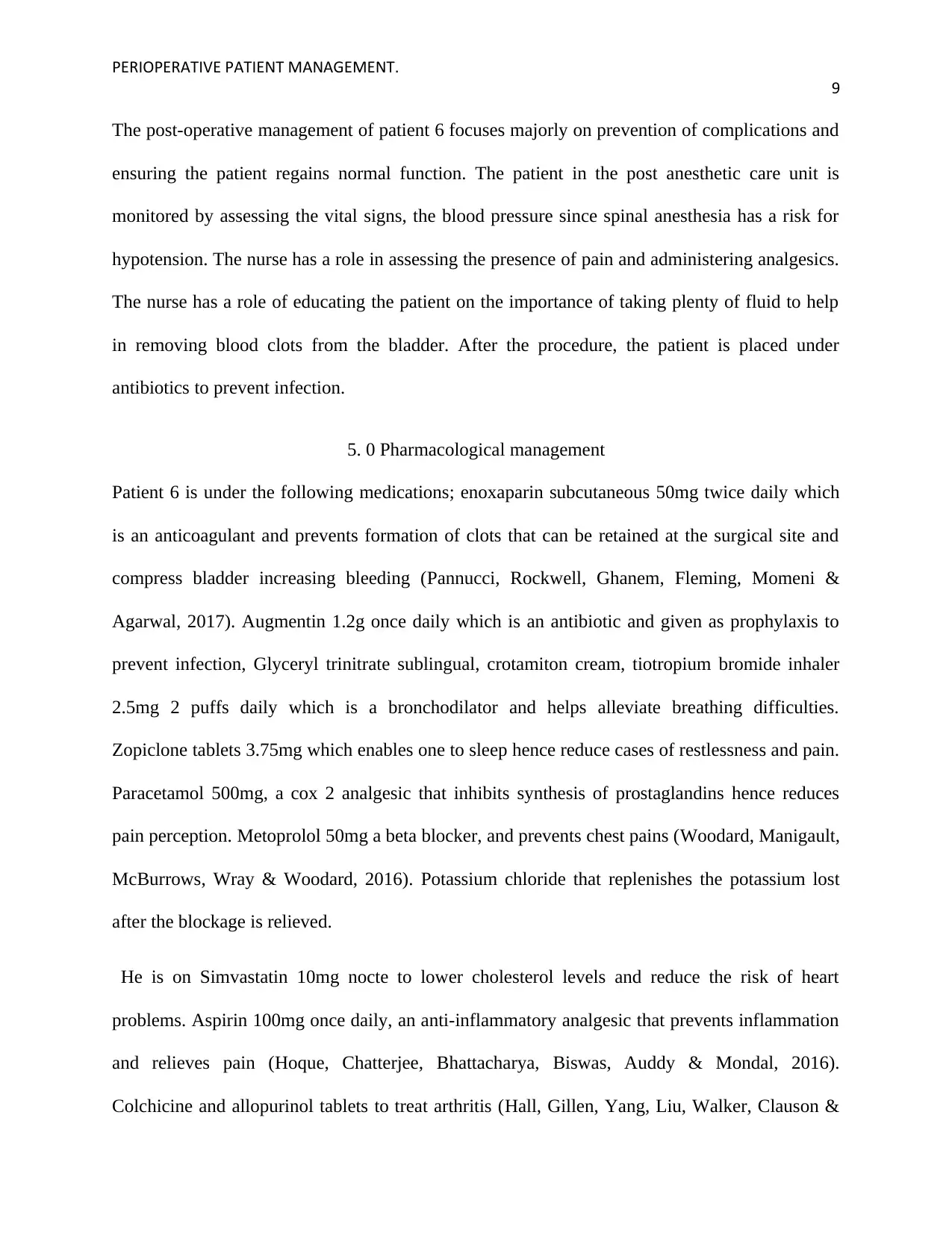
PERIOPERATIVE PATIENT MANAGEMENT.
9
The post-operative management of patient 6 focuses majorly on prevention of complications and
ensuring the patient regains normal function. The patient in the post anesthetic care unit is
monitored by assessing the vital signs, the blood pressure since spinal anesthesia has a risk for
hypotension. The nurse has a role in assessing the presence of pain and administering analgesics.
The nurse has a role of educating the patient on the importance of taking plenty of fluid to help
in removing blood clots from the bladder. After the procedure, the patient is placed under
antibiotics to prevent infection.
5. 0 Pharmacological management
Patient 6 is under the following medications; enoxaparin subcutaneous 50mg twice daily which
is an anticoagulant and prevents formation of clots that can be retained at the surgical site and
compress bladder increasing bleeding (Pannucci, Rockwell, Ghanem, Fleming, Momeni &
Agarwal, 2017). Augmentin 1.2g once daily which is an antibiotic and given as prophylaxis to
prevent infection, Glyceryl trinitrate sublingual, crotamiton cream, tiotropium bromide inhaler
2.5mg 2 puffs daily which is a bronchodilator and helps alleviate breathing difficulties.
Zopiclone tablets 3.75mg which enables one to sleep hence reduce cases of restlessness and pain.
Paracetamol 500mg, a cox 2 analgesic that inhibits synthesis of prostaglandins hence reduces
pain perception. Metoprolol 50mg a beta blocker, and prevents chest pains (Woodard, Manigault,
McBurrows, Wray & Woodard, 2016). Potassium chloride that replenishes the potassium lost
after the blockage is relieved.
He is on Simvastatin 10mg nocte to lower cholesterol levels and reduce the risk of heart
problems. Aspirin 100mg once daily, an anti-inflammatory analgesic that prevents inflammation
and relieves pain (Hoque, Chatterjee, Bhattacharya, Biswas, Auddy & Mondal, 2016).
Colchicine and allopurinol tablets to treat arthritis (Hall, Gillen, Yang, Liu, Walker, Clauson &
9
The post-operative management of patient 6 focuses majorly on prevention of complications and
ensuring the patient regains normal function. The patient in the post anesthetic care unit is
monitored by assessing the vital signs, the blood pressure since spinal anesthesia has a risk for
hypotension. The nurse has a role in assessing the presence of pain and administering analgesics.
The nurse has a role of educating the patient on the importance of taking plenty of fluid to help
in removing blood clots from the bladder. After the procedure, the patient is placed under
antibiotics to prevent infection.
5. 0 Pharmacological management
Patient 6 is under the following medications; enoxaparin subcutaneous 50mg twice daily which
is an anticoagulant and prevents formation of clots that can be retained at the surgical site and
compress bladder increasing bleeding (Pannucci, Rockwell, Ghanem, Fleming, Momeni &
Agarwal, 2017). Augmentin 1.2g once daily which is an antibiotic and given as prophylaxis to
prevent infection, Glyceryl trinitrate sublingual, crotamiton cream, tiotropium bromide inhaler
2.5mg 2 puffs daily which is a bronchodilator and helps alleviate breathing difficulties.
Zopiclone tablets 3.75mg which enables one to sleep hence reduce cases of restlessness and pain.
Paracetamol 500mg, a cox 2 analgesic that inhibits synthesis of prostaglandins hence reduces
pain perception. Metoprolol 50mg a beta blocker, and prevents chest pains (Woodard, Manigault,
McBurrows, Wray & Woodard, 2016). Potassium chloride that replenishes the potassium lost
after the blockage is relieved.
He is on Simvastatin 10mg nocte to lower cholesterol levels and reduce the risk of heart
problems. Aspirin 100mg once daily, an anti-inflammatory analgesic that prevents inflammation
and relieves pain (Hoque, Chatterjee, Bhattacharya, Biswas, Auddy & Mondal, 2016).
Colchicine and allopurinol tablets to treat arthritis (Hall, Gillen, Yang, Liu, Walker, Clauson &
⊘ This is a preview!⊘
Do you want full access?
Subscribe today to unlock all pages.

Trusted by 1+ million students worldwide
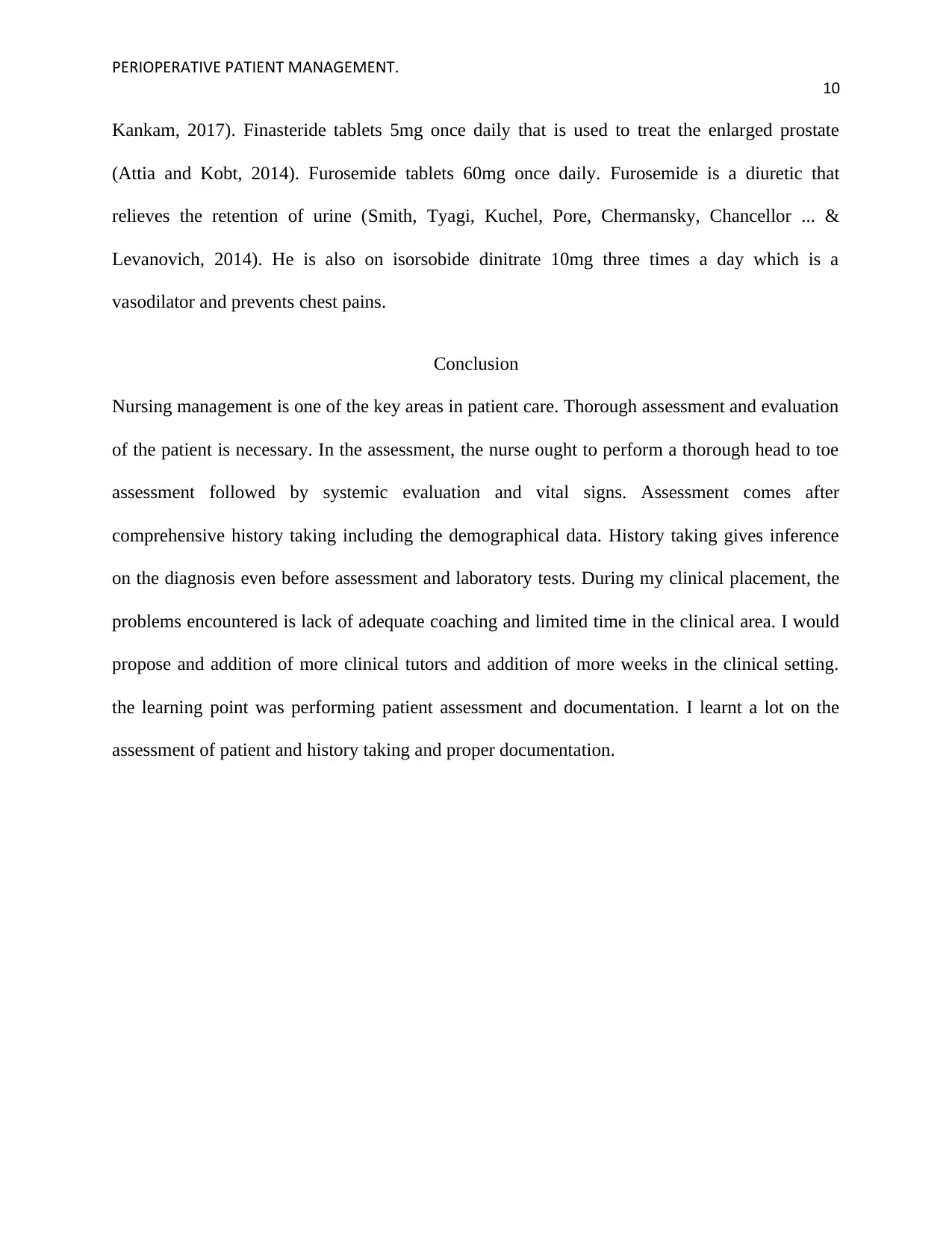
PERIOPERATIVE PATIENT MANAGEMENT.
10
Kankam, 2017). Finasteride tablets 5mg once daily that is used to treat the enlarged prostate
(Attia and Kobt, 2014). Furosemide tablets 60mg once daily. Furosemide is a diuretic that
relieves the retention of urine (Smith, Tyagi, Kuchel, Pore, Chermansky, Chancellor ... &
Levanovich, 2014). He is also on isorsobide dinitrate 10mg three times a day which is a
vasodilator and prevents chest pains.
Conclusion
Nursing management is one of the key areas in patient care. Thorough assessment and evaluation
of the patient is necessary. In the assessment, the nurse ought to perform a thorough head to toe
assessment followed by systemic evaluation and vital signs. Assessment comes after
comprehensive history taking including the demographical data. History taking gives inference
on the diagnosis even before assessment and laboratory tests. During my clinical placement, the
problems encountered is lack of adequate coaching and limited time in the clinical area. I would
propose and addition of more clinical tutors and addition of more weeks in the clinical setting.
the learning point was performing patient assessment and documentation. I learnt a lot on the
assessment of patient and history taking and proper documentation.
10
Kankam, 2017). Finasteride tablets 5mg once daily that is used to treat the enlarged prostate
(Attia and Kobt, 2014). Furosemide tablets 60mg once daily. Furosemide is a diuretic that
relieves the retention of urine (Smith, Tyagi, Kuchel, Pore, Chermansky, Chancellor ... &
Levanovich, 2014). He is also on isorsobide dinitrate 10mg three times a day which is a
vasodilator and prevents chest pains.
Conclusion
Nursing management is one of the key areas in patient care. Thorough assessment and evaluation
of the patient is necessary. In the assessment, the nurse ought to perform a thorough head to toe
assessment followed by systemic evaluation and vital signs. Assessment comes after
comprehensive history taking including the demographical data. History taking gives inference
on the diagnosis even before assessment and laboratory tests. During my clinical placement, the
problems encountered is lack of adequate coaching and limited time in the clinical area. I would
propose and addition of more clinical tutors and addition of more weeks in the clinical setting.
the learning point was performing patient assessment and documentation. I learnt a lot on the
assessment of patient and history taking and proper documentation.
Paraphrase This Document
Need a fresh take? Get an instant paraphrase of this document with our AI Paraphraser
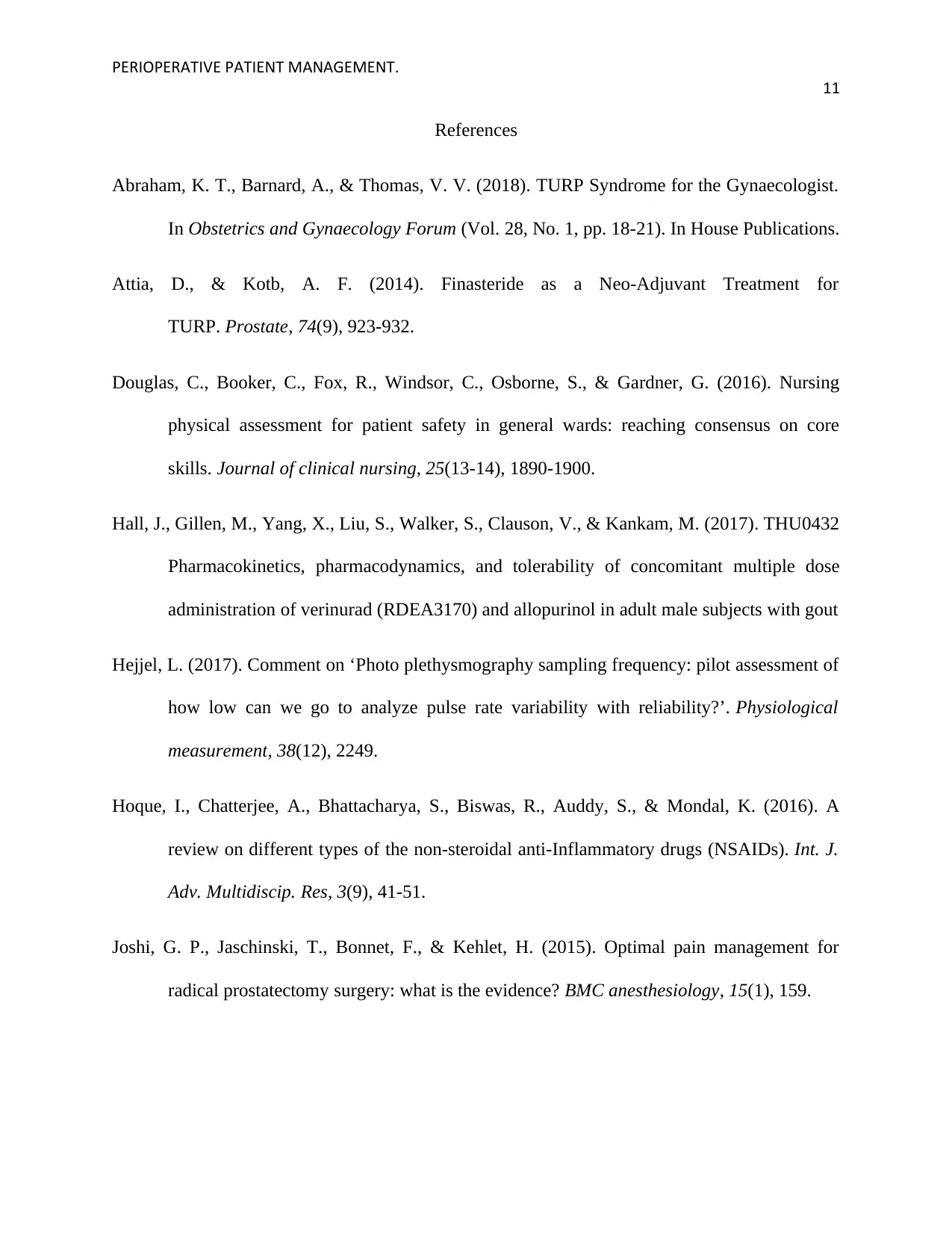
PERIOPERATIVE PATIENT MANAGEMENT.
11
References
Abraham, K. T., Barnard, A., & Thomas, V. V. (2018). TURP Syndrome for the Gynaecologist.
In Obstetrics and Gynaecology Forum (Vol. 28, No. 1, pp. 18-21). In House Publications.
Attia, D., & Kotb, A. F. (2014). Finasteride as a Neo-Adjuvant Treatment for
TURP. Prostate, 74(9), 923-932.
Douglas, C., Booker, C., Fox, R., Windsor, C., Osborne, S., & Gardner, G. (2016). Nursing
physical assessment for patient safety in general wards: reaching consensus on core
skills. Journal of clinical nursing, 25(13-14), 1890-1900.
Hall, J., Gillen, M., Yang, X., Liu, S., Walker, S., Clauson, V., & Kankam, M. (2017). THU0432
Pharmacokinetics, pharmacodynamics, and tolerability of concomitant multiple dose
administration of verinurad (RDEA3170) and allopurinol in adult male subjects with gout
Hejjel, L. (2017). Comment on ‘Photo plethysmography sampling frequency: pilot assessment of
how low can we go to analyze pulse rate variability with reliability?’. Physiological
measurement, 38(12), 2249.
Hoque, I., Chatterjee, A., Bhattacharya, S., Biswas, R., Auddy, S., & Mondal, K. (2016). A
review on different types of the non-steroidal anti-Inflammatory drugs (NSAIDs). Int. J.
Adv. Multidiscip. Res, 3(9), 41-51.
Joshi, G. P., Jaschinski, T., Bonnet, F., & Kehlet, H. (2015). Optimal pain management for
radical prostatectomy surgery: what is the evidence? BMC anesthesiology, 15(1), 159.
11
References
Abraham, K. T., Barnard, A., & Thomas, V. V. (2018). TURP Syndrome for the Gynaecologist.
In Obstetrics and Gynaecology Forum (Vol. 28, No. 1, pp. 18-21). In House Publications.
Attia, D., & Kotb, A. F. (2014). Finasteride as a Neo-Adjuvant Treatment for
TURP. Prostate, 74(9), 923-932.
Douglas, C., Booker, C., Fox, R., Windsor, C., Osborne, S., & Gardner, G. (2016). Nursing
physical assessment for patient safety in general wards: reaching consensus on core
skills. Journal of clinical nursing, 25(13-14), 1890-1900.
Hall, J., Gillen, M., Yang, X., Liu, S., Walker, S., Clauson, V., & Kankam, M. (2017). THU0432
Pharmacokinetics, pharmacodynamics, and tolerability of concomitant multiple dose
administration of verinurad (RDEA3170) and allopurinol in adult male subjects with gout
Hejjel, L. (2017). Comment on ‘Photo plethysmography sampling frequency: pilot assessment of
how low can we go to analyze pulse rate variability with reliability?’. Physiological
measurement, 38(12), 2249.
Hoque, I., Chatterjee, A., Bhattacharya, S., Biswas, R., Auddy, S., & Mondal, K. (2016). A
review on different types of the non-steroidal anti-Inflammatory drugs (NSAIDs). Int. J.
Adv. Multidiscip. Res, 3(9), 41-51.
Joshi, G. P., Jaschinski, T., Bonnet, F., & Kehlet, H. (2015). Optimal pain management for
radical prostatectomy surgery: what is the evidence? BMC anesthesiology, 15(1), 159.
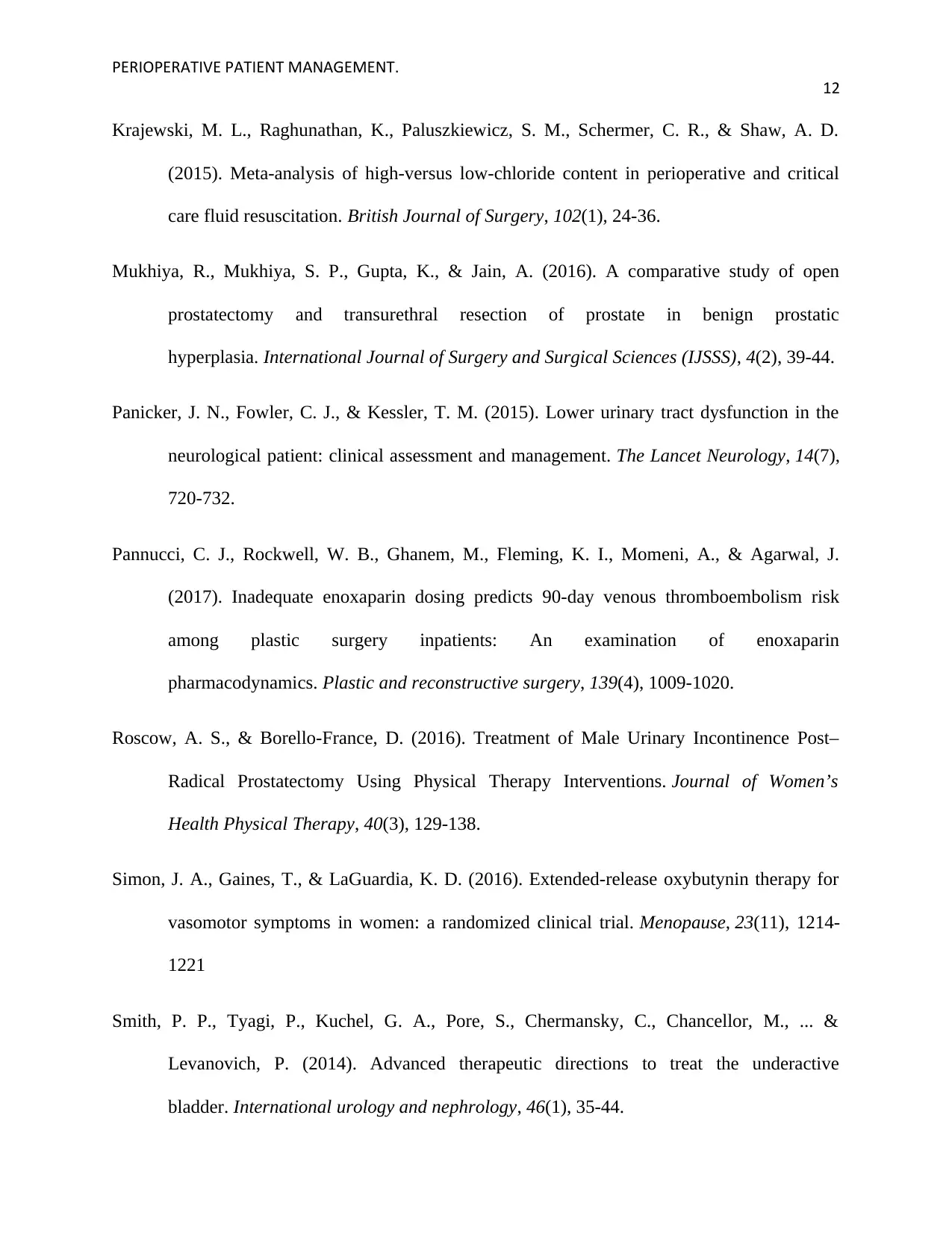
PERIOPERATIVE PATIENT MANAGEMENT.
12
Krajewski, M. L., Raghunathan, K., Paluszkiewicz, S. M., Schermer, C. R., & Shaw, A. D.
(2015). Meta‐analysis of high‐versus low‐chloride content in perioperative and critical
care fluid resuscitation. British Journal of Surgery, 102(1), 24-36.
Mukhiya, R., Mukhiya, S. P., Gupta, K., & Jain, A. (2016). A comparative study of open
prostatectomy and transurethral resection of prostate in benign prostatic
hyperplasia. International Journal of Surgery and Surgical Sciences (IJSSS), 4(2), 39-44.
Panicker, J. N., Fowler, C. J., & Kessler, T. M. (2015). Lower urinary tract dysfunction in the
neurological patient: clinical assessment and management. The Lancet Neurology, 14(7),
720-732.
Pannucci, C. J., Rockwell, W. B., Ghanem, M., Fleming, K. I., Momeni, A., & Agarwal, J.
(2017). Inadequate enoxaparin dosing predicts 90-day venous thromboembolism risk
among plastic surgery inpatients: An examination of enoxaparin
pharmacodynamics. Plastic and reconstructive surgery, 139(4), 1009-1020.
Roscow, A. S., & Borello-France, D. (2016). Treatment of Male Urinary Incontinence Post–
Radical Prostatectomy Using Physical Therapy Interventions. Journal of Women’s
Health Physical Therapy, 40(3), 129-138.
Simon, J. A., Gaines, T., & LaGuardia, K. D. (2016). Extended-release oxybutynin therapy for
vasomotor symptoms in women: a randomized clinical trial. Menopause, 23(11), 1214-
1221
Smith, P. P., Tyagi, P., Kuchel, G. A., Pore, S., Chermansky, C., Chancellor, M., ... &
Levanovich, P. (2014). Advanced therapeutic directions to treat the underactive
bladder. International urology and nephrology, 46(1), 35-44.
12
Krajewski, M. L., Raghunathan, K., Paluszkiewicz, S. M., Schermer, C. R., & Shaw, A. D.
(2015). Meta‐analysis of high‐versus low‐chloride content in perioperative and critical
care fluid resuscitation. British Journal of Surgery, 102(1), 24-36.
Mukhiya, R., Mukhiya, S. P., Gupta, K., & Jain, A. (2016). A comparative study of open
prostatectomy and transurethral resection of prostate in benign prostatic
hyperplasia. International Journal of Surgery and Surgical Sciences (IJSSS), 4(2), 39-44.
Panicker, J. N., Fowler, C. J., & Kessler, T. M. (2015). Lower urinary tract dysfunction in the
neurological patient: clinical assessment and management. The Lancet Neurology, 14(7),
720-732.
Pannucci, C. J., Rockwell, W. B., Ghanem, M., Fleming, K. I., Momeni, A., & Agarwal, J.
(2017). Inadequate enoxaparin dosing predicts 90-day venous thromboembolism risk
among plastic surgery inpatients: An examination of enoxaparin
pharmacodynamics. Plastic and reconstructive surgery, 139(4), 1009-1020.
Roscow, A. S., & Borello-France, D. (2016). Treatment of Male Urinary Incontinence Post–
Radical Prostatectomy Using Physical Therapy Interventions. Journal of Women’s
Health Physical Therapy, 40(3), 129-138.
Simon, J. A., Gaines, T., & LaGuardia, K. D. (2016). Extended-release oxybutynin therapy for
vasomotor symptoms in women: a randomized clinical trial. Menopause, 23(11), 1214-
1221
Smith, P. P., Tyagi, P., Kuchel, G. A., Pore, S., Chermansky, C., Chancellor, M., ... &
Levanovich, P. (2014). Advanced therapeutic directions to treat the underactive
bladder. International urology and nephrology, 46(1), 35-44.
⊘ This is a preview!⊘
Do you want full access?
Subscribe today to unlock all pages.

Trusted by 1+ million students worldwide
1 out of 13
Your All-in-One AI-Powered Toolkit for Academic Success.
+13062052269
info@desklib.com
Available 24*7 on WhatsApp / Email
![[object Object]](/_next/static/media/star-bottom.7253800d.svg)
Unlock your academic potential
Copyright © 2020–2025 A2Z Services. All Rights Reserved. Developed and managed by ZUCOL.
